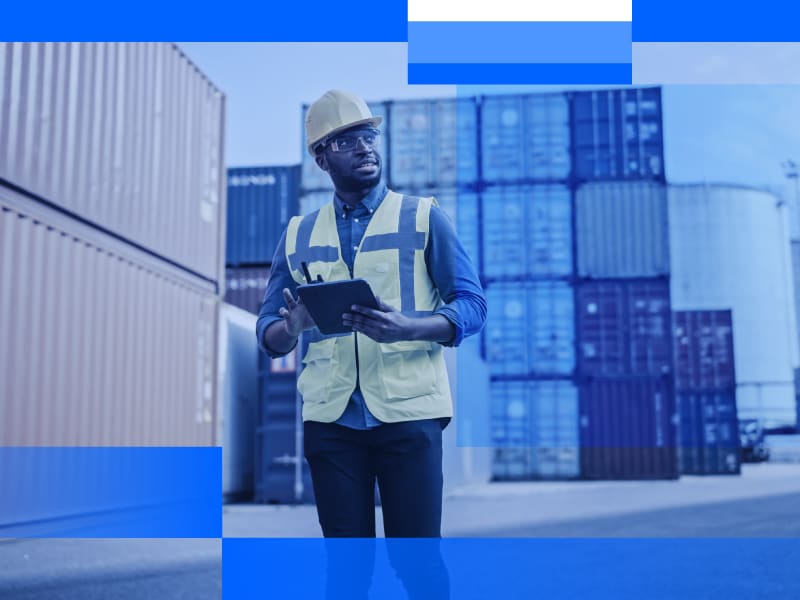Home > TradeEdge > Blogs > Key Strategies to Enable a Resilient Supply Chain for The Post-Covid Future
Key Strategies to Enable a Resilient Supply Chain for The Post-Covid Future

In a time of fierce competition from specialized companies, e-commerce acquiring a larger market share, and a general shift in customers’ purchasing behaviors, the CPG sector has proliferated in recent years. This led to a significant uproar in the supply chain network.
COVID-19 has strongly emphasized our systems’ flaws, from public health to global supply chain networks. Essential supplies had been in short supply throughout the world. Even while businesses stabilize, the dynamic nature of demand and the ongoing economic pressures leave room for improvement. The shortage is primarily due to a complete lack of visibility into the supply chain network.
The Importance of Supply Chain Resilience
Supply chains that are reliable, adaptable, and sustainable are critical to the resiliency of the construction and infrastructure industries. Organizations have already started considering alternative ways for integrating future resilience as lessons acquired from the COVID-19 pandemic are used.
Optimizing supply chain resilience necessitates a holistic approach that considers all layers. Critical programs and spend categories will require strategic supply chain maps to help identify potential areas of failure in future shocks.
Cloud-based supply chain management systems can enhance forecasting and notification of interruption repercussions. Analytics are set to determine existing resilience measures’ potential effectiveness and suggest any necessary mitigation actions before it’s too late.
What is Supply Chain Resilience
Connectedness and Cognition
The concept of supply chain resilience isn’t new; it’s been debated in academia, C-suite, and on the shop floor for years. Experts have debated risk mitigation, adaptability, and the cultural shifts required to achieve resilience since the early 2000s.
There is no foolproof way to avoid all the dangers, especially high-impact/low-probability occurrences like SARS, foot-and-mouth disease, or a sizeable terrorist strike. Furthermore, the lack of historical data precludes predictive statistical tools from aiding in risk containment.
The current pandemic has highlighted the importance of creating supply chain resilience. Now more than ever, enterprises require supply networks to recover from the current crisis and maintain stability in the aftermath.
We believe that supply chain resilience is defined by two characteristics: its ability to be “connected” and “cognitive.” All components of a connected supply chain — wholesalers, retailers, and local stores have accurate, end-to-end, near real-time visibility. A cognitive supply chain thus uses the data gathered due to its interconnectedness to learn and produce actionable insights.
Building a Solid Foundation Connectedness
A linked supply chain is one in which wholesalers, retailers, and local stores — have accurate, end-to-end, near-real-time visibility. And increased visibility of your supply chain empowers you to closely track products as they travel from supplier to manufacturer and finally to consumer.
Supply chain visibility gives you more control over your inventories, costs, various disruptions, and risks. Here, data is the connecting link fetching valuable insights from the entire supply chain network, helping companies in the following ways:
Versatile and cost-effective data collection strengthens a worldwide consumer products company’s overall demand planning. For instance, TradeEdge Market Connect also resulted in a 4-10% increase in sales, in addition to the considerable cost reductions.
The Power of Cognition
A cognitive supply chain uses the data gathered due to its interconnectedness to learn and produce actionable insights.
The supply chain generates massive amounts of data. Mostly, this data is unstructured across various documents, emails, files, invoices, and others. Analyzing them manually is no more an accepted practice given the short time companies get to make decisions.
With the help of analytics, CPG companies can get a structured summary of relevant data in the shape of graphs, charts, images, and valuable insights for making data-driven decisions. Automatic data exchange enabled by machine learning is the best bet for CPGs as the process will:
End-to-end supply chain transparency improves sales and organizational performance for a multinational beverage firm. For example, TradeEdge Market Connect contributed to a 90% reduction in manual reporting, a 20% reduction in stock-outs, and a 10% boost in case-fill rates.
Influence of Pandemic on the Supply Chain Network
The COVID-19 pandemic has put 20 years of supply chain resilience study, debate, and preparation to the test. The challenge for companies will be to strengthen their supply chains while maintaining their competitiveness.
EdgeVerve thus believes that a connected and cognitive supply chain is essential for a sustainable company. Enterprises can accomplish this objective using the TradeEdge suite of solutions.


Possibilities Unlimited
Possibilities Unlimited
Inspiring enterprises with the power of digital platforms
More blogs from EdgeVerve →